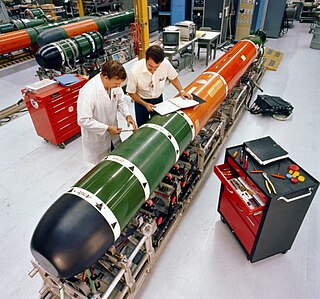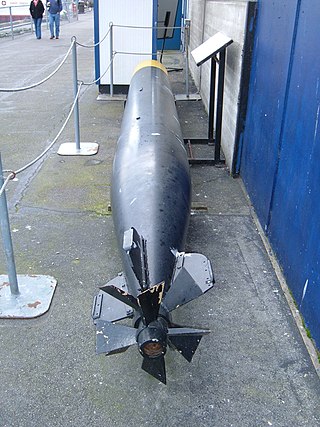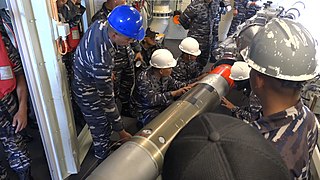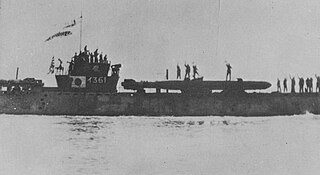
A modern torpedo is an underwater ranged weapon launched above or below the water surface, self-propelled towards a target, and with an explosive warhead designed to detonate either on contact with or in proximity to the target. Historically, such a device was called an automotive, automobile, locomotive, or fish torpedo; colloquially a fish. The term torpedo originally applied to a variety of devices, most of which would today be called mines. From about 1900, torpedo has been used strictly to designate a self-propelled underwater explosive device.

The Naval Undersea Warfare Center (NUWC) is the United States Navy's full-spectrum research, development, test and evaluation, engineering and fleet support center for submarines, autonomous underwater systems, and offensive and defensive weapons systems associated with undersea warfare. It is one of the corporate laboratories of the Naval Sea Systems Command. NUWC is headquartered in Newport, Rhode Island and has two major subordinate activities: Division Newport and Division Keyport in Keyport, Washington. NUWC also controls the Fox Island facility and Gould Island. It employs more than 4,400 civilian and military personnel, with budgets over $1 billion.

Tench-class submarines were a type of submarine built for the United States Navy (USN) between 1944 and 1951. They were an improvement over the Gato and Balao classes, only about 35 to 40 tons larger, but more strongly built and with a slightly improved internal layout. One of the ballast tanks was converted to carry fuel, increasing range from 11,000 nautical miles to 16,000 nautical miles. This improvement was also made on some boats of the previous two classes. Further improvements were made beginning with SS-435, which are sometimes referred to as the Corsair class. Initial plans called for 80 to be built, but 51 were cancelled in 1944 and 1945 when it became apparent that they would not be needed to defeat Japan. The remaining 29 were commissioned between October 1944 (Tench) and February 1951 (Grenadier). The last submarine of the Tench class, as well as the last submarine which served during World War II, remaining in service with the U.S. Navy was USS Tigrone (AGSS-419) which was decommissioned on 27 June 1975.

The Mark 48 and its improved Advanced Capability (ADCAP) variant are American heavyweight submarine-launched torpedoes. They were designed to sink deep-diving nuclear-powered submarines and high-performance surface ships.

The Mark 46 torpedo is the backbone of the United States Navy's lightweight anti-submarine warfare torpedo inventory and is the NATO standard. These aerial torpedoes are designed to attack high-performance submarines. In 1989, an improvement program for the Mod 5 to the Mod 5A and Mod 5A(S) increased its shallow-water performance. The Mark 46 was initially developed as Research Torpedo Concept I, one of several weapons recommended for implementation by Project Nobska, a 1956 summer study on submarine warfare.

The Hedgehog was a forward-throwing anti-submarine weapon that was used primarily during the Second World War. The device, which was developed by the Royal Navy, fired up to 24 spigot mortars ahead of a ship when attacking a U-boat. It was deployed on convoy escort warships such as destroyers and corvettes to supplement the depth charges.

The G7e torpedo was the standard electric torpedo used by the German Kriegsmarine submarines in World War II. It came in 20 different versions, with the initial model G7e(TII) in service at the outbreak of the war. Due to several problems, leading to the German "Torpedokrise" which lasted until the end of 1941, the improved G7e(TIII) took over as the standard electric torpedo used by German U-boats for the rest of the war. G7e torpedoes measured 533.4 mm (21.00 in) in diameter and about 7.2 m (24 ft) in length. Depending on the type, the warhead contained a main charge of 250–280 kg (550–620 lb) of Schießwolle 36, a mixture of dipicrylamine and TNT. All were powered by 60–72 kW (80–100 hp) electric motors and lead-acid batteries which required onboard maintenance to maintain their functionality.

The Mark 45 anti-submarine torpedo, a.k.a. ASTOR, was a submarine-launched wire-guided nuclear torpedo designed by the United States Navy for use against high-speed, deep-diving, enemy submarines. This was one of several weapons recommended for implementation by Project Nobska, a 1956 summer study on submarine warfare. The 19-inch (483 mm) torpedo was fitted with a W34 nuclear warhead. The need to maintain direct control over the warhead meant that a wire connection had to be maintained between the torpedo and submarine until detonation. Wire guidance systems were piggybacked onto this cable, and the torpedo had no homing capability. The design was completed in 1957, and 600 torpedoes were built before 1976, whereupon ASTOR was replaced by the Mark 48 torpedo.

The Mark 13 torpedo was the U.S. Navy's most common aerial torpedo of World War II. It was the first American torpedo to be originally designed for launching from aircraft only. They were also used on PT boats.

An acoustic torpedo is a torpedo that aims itself by listening for characteristic sounds of its target or by searching for it using sonar. Acoustic torpedoes are usually designed for medium-range use, and often fired from a submarine.

The Mark 24 mine is an air-dropped anti-submarine (ASW) acoustic torpedo developed by the United States during World War II; it was called a mine to conceal its capabilities. The torpedo entered service with the Allies in March 1943; the United States Navy (USN) used it until 1948. Approximately 4,000 were produced. Of the 340 deployed during the war, 204 were fired, sinking 37 and damaging 18 Axis submarines.

The Mark 37 torpedo is a torpedo with electrical propulsion, developed for the US Navy after World War II. It entered service with the US Navy in the early 1950s, with over 3,300 produced. It was phased out of service with the US Navy during the 1970s, and the stockpiles were sold to foreign navies.

The Mark 14 torpedo was the United States Navy's standard submarine-launched anti-ship torpedo of World War II. This weapon was plagued with many problems which crippled its performance early in the war. It was supplemented by the Mark 18 electric torpedo in the last two years of the war. From December 1941 to November 1943 the Mark 14 and the destroyer-launched Mark 15 torpedo had numerous technical problems that took almost two years to fix. After the fixes, the Mark 14 played a major role in the devastating blow U.S. Navy submarines dealt to the Japanese naval and merchant marine forces during the Pacific War.

The A244/S is an Italian lightweight, fire-and-forget torpedo employed for anti-submarine warfare. It can be launched from surface vessels or aircraft and locates the target using an acoustic seeker. The torpedo body conforms to the NATO 12.75-inch standard and is compatible with USN Mark 32 torpedo tubes.
There have been a number of 18-inch (45cm) torpedoes in service with the Royal Navy of the United Kingdom.
There have been a number of 21-inch (53.3cm) torpedoes in service with the Royal Navy of the United Kingdom.
The Mark 10 torpedo was a torpedo put into use by the United States in 1915. It was derived from the Mark 9 aircraft torpedo converted to submarine use. It was used as the primary torpedo in the R- and S-class submarines. It used alcohol-water steam turbine propulsion. It was succeeded by the problematic Mark 14 torpedo, but remained in service in S-boats and fleet submarines through the Pacific War. The Mark 10 featured the largest warhead of any U.S. torpedo developed at that time. Stockpiles of Mark 10 Mod 3 torpedoes were used extensively during the first part of World War II due to short supply of the newer and longer (246 in Mark 14s, with some fleet submarines carrying a mixture of both types on patrol.
The Mark 21 Mod 2 torpedo, was a passive acoustic homing variant of the Mark 13 torpedo. It used the widely used Mark 13 torpedo as a basis, with the addition of passive acoustic homing developed by Bell Labs.
I-368 was an Imperial Japanese Navy Type D1 transport submarine. Completed and commissioned in August 1944, she served in World War II and was converted into a kaiten suicide attack torpedo carrier in January 1945. She was sunk in February 1945 while operating during the Battle of Iwo Jima.

I-361 was an Imperial Japanese Navy Type D1 transport submarine. Completed and commissioned in May 1944, she served in World War II and conducted transport missions between Japan and Wake Island until she was converted into a kaiten suicide attack torpedo carrier 1945. She was sunk during her first kaiten mission in May 1945.














